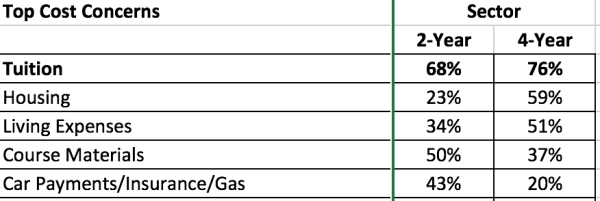David Wiley has added to the conversation1 over use of data on college textbook pricing and student spending patterns with “The Practical Cost of Textbooks”. The key argument is to go beyond prices and spending and look at the most direct measure of asking students themselves how textbooks costs have impacted them. He then looks at the Florida Virtual Campus surveys (also included in my post), concluding:
What impact does the cost of textbooks have on students? Textbook costs cause students to occasionally or frequently take fewer courses (35% of students), to drop or withdraw from courses (24%), and to earn either poor or failing grades (26%). Regardless of whether you have historically preferred the College Board number or the student survey number, a third fact that is beyond dispute is that surveys of students indicate that the cost of textbooks negatively impacts their learning (grades) and negatively impacts their time to graduation (drops, withdraws, and credits).
And yes, we need to do something about it.
Amen. Surveying over 18,000 students, the FVC surveys are quite important and should be on everyone’s radar.
More Out Of Data
I strongly feel that this type of discussion (as well as media quotes, policy, and legislation) should use the best data available, describe that data accurately, and ask for more data where there are holes. And it often takes multiple views into multiple data sources to get a complete picture. For the College Board / IPEDS data, it is indisputable what it says, but descriptions of the source should note that it comes from financial aid offices and not from student spending or budgets. For the student spending data (Student Monitor, NACS, Cal State), the data is solid and accurately described (that I have seen), but as reported they are missing segmentation across key student demographics.
In Mike Caulfield’s post he argues that it’s all well and good that students are creatively reducing their textbook expenses by renting, borrowing, etc, but that this data can mask other important factors.
You could use skills like this to cobble together that bag of books and say *that’s* the true cost. Look what you can get your books for if you game the system right!
But to say that, you’d have to have learned nothing in the past decade about why students fail. Requiring a non-traditional student to cobble together a bag of half-priced textbooks the way a second-generation student might is setting them up for failure.
Since I have argued that the student spending data is critical and much more relevant than the College Board data, let’s explore that data further – asking for more. Richard Hershman and NACS were kind enough to agree to requests for cross-tabs on two of their questions against sector and first-generation status.
For Fall 2014, students were asked how much they spent on required course materials.
It turns out that Mike is right. First-generation students spend 10 % more, acquire 6% fewer textbooks, and end up paying 17% more per textbook than do non first-generation students. This data could be used as a starting point for policy that addresses this problem – explaining the problem and providing a measurement for improvement.
For Spring 2015, students were asked to list their top 3 cost concerns for college.
First-generation students are somewhat more likely to worry about course materials (41% to 37%) than non first-generation students, but the view across sectors is more telling. 2-year college students are much more likely to worry about course materials (50% to 37%) than 4-year college students. Tuition is lower at 2-year schools, and fewer student live on campus or away from home. So it makes sense that course material concerns would increase in relative terms (% listing in top 3 concerns). It also makes sense how car payments / insurance / gas would be more important.
These are real issues of equity, and accurate understanding of multiple data sources is more likely to lead to effective policy decisions than using single sources. And you get that data by exploring it further and seeing where it takes you.
- My initial post, Mike Caulfield response, Bracken Mosbacker, my response to Mike, Mike follow-up [↩]



[…] By Phil HillMore Posts (377) David Wiley has added to the conversation[1] over use of data on college textbook pricing and student spending patterns with “The Practical Cost of Textbooks”. The key argument is to go beyond prices and spending and look at … Continue reading → […]